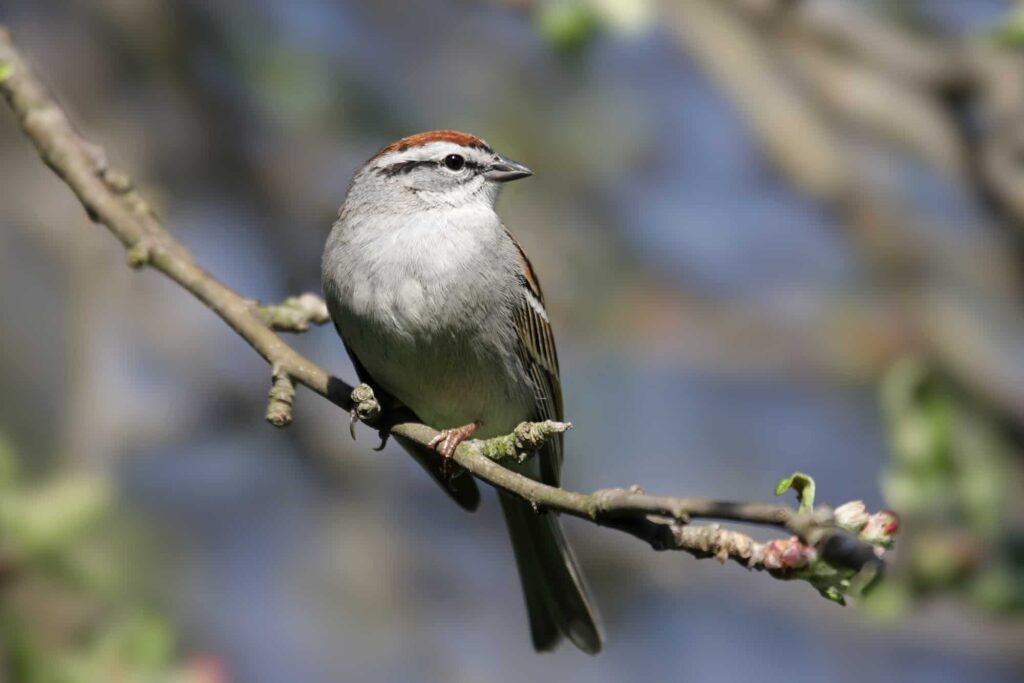Maryland’s cities, waterways, mountains, lakes, parks, and fields offer plentiful habitats for countless sparrows every year. These little birds — mostly brown in color — are found year-round in Maryland, although not all species stay put all year.
In addition to sparrows, Maryland is home to other fascinating birds, including birds of prey, waterfowl, hummingbirds, songbirds, and so many more. You can check out our Maryland Bird Guide to learn more about the birds that inhabit or visit Maryland.
18 different kinds of sparrows call Maryland home for at least part of the year. Whether you’re in the woods or on the water, in a city, or on a farm, you can probably spot some sparrows nearby!
What Makes a Sparrow a Sparrow?
According to the Spruce, “sparrow” is a catch-all term for a wide range of little brown birds that are sometimes called “LBJs.” LBJ = Little Brown Job.
Because they are small, fast, and similarly colored, they can be difficult to identify. You may be able to quickly recognize that a sparrow is a sparrow, but it can be quite a challenge to figure out which species is which.
Although many sparrows have the word sparrow in their names, plenty of others have names like buntings, towhees, and juncos.
Sparrows are Passerines — that is, songbirds. They are usually between 4-8 inches long and have a short, stocky, cone-shaped bill. Their brown coloring makes them excellent at camouflage.
How Many Sparrows Are in Maryland?
18 different kinds of sparrows visit Maryland every year and a handful of them stick around all year.
Additionally, a rare vagrant of another species will find its way to Maryland, but our list will only take a look at the sparrows we can say with confidence that you will encounter in Maryland.
To identify a sparrow, pay attention to the following:
- Size
- Coloring and patterns
- Behaviors
- Habitat
- When you observed them
- What part of the state you saw them in
If you’re up for a challenge, we hope our list helps you identify the sparrows you see in Maryland. We have divided the list into four groups to help make it easier: year-round sparrows, summer sparrows, winter sparrows, and migration-only sparrows.
Let’s jump right in!
Year-round Sparrows in Maryland
These are the sparrows that live year-round in Maryland: the Eastern Towhee, the House Sparrow, the Saltmarsh Sparrow, the Savannah Sparrow, and the Song Sparrow. When a bird has a year-round presence in a state, that can mean that individual birds stay put all year long, or it could mean that their migration patterns align so that some individuals are present in the summer and others in the winter.
Eastern Towhee

- Pipilo erythrophthalmus
- ORDER: Passeriformes
- FAMILY: Passerellidae
- Length: 6.8-8.2 in (17.3-20.8 cm)
- Weight: 1.1-1.8 oz (32-52 g)
- Wingspan: 7.9-11.0 in (20-28 cm)
The Eastern Towhee male has a dark black head, back, and neck. His belly is white and his sides are rufous. Females have similar patterning, but instead of black and white, they are brown and white.
Eastern Towhees make a “chewink” call and hide in the shrubby undergrowth of Maryland’s forests.
They are widespread throughout much of the eastern US. In Western Maryland, they are summer residents who leave in the fall. In the east, they are year-round residents.
House Sparrow

- Passer domesticus
- ORDER: Passeriformes
- FAMILY: Passeridae
- Length: 5.9-6.7 in (15-17 cm)
- Weight: 0.9-1.1 oz (27-30 g)
- Wingspan: 7.5-9.8 in (19-25 cm)
The House Sparrow earned its name from its habit of thriving in environments with lots of human activity. Specifically, they nest in human-made structures like barns and houses.
Males are gray-headed with a rufous neck, white cheeks, and a black bib. Females are striped in light and dark brown.
As one of the most common birds in North America, House Sparrows do not migrate. They stay put year-round no matter where they are from — including Maryland. They are widespread throughout the state.
House Sparrows are very social birds who gather in large flocks. If you’ve heard a noisy group of sparrows in a bush or a tree, there’s a good chance that you were hearing House Sparrows.
House Sparrows engage in behaviors that displace native species from the areas where they live. For example, they will take over birdfeeders and nesting boxes, driving out other birds like Eastern Bluebirds. This makes them unpopular with naturalists and some birders.
Saltmarsh Sparrow
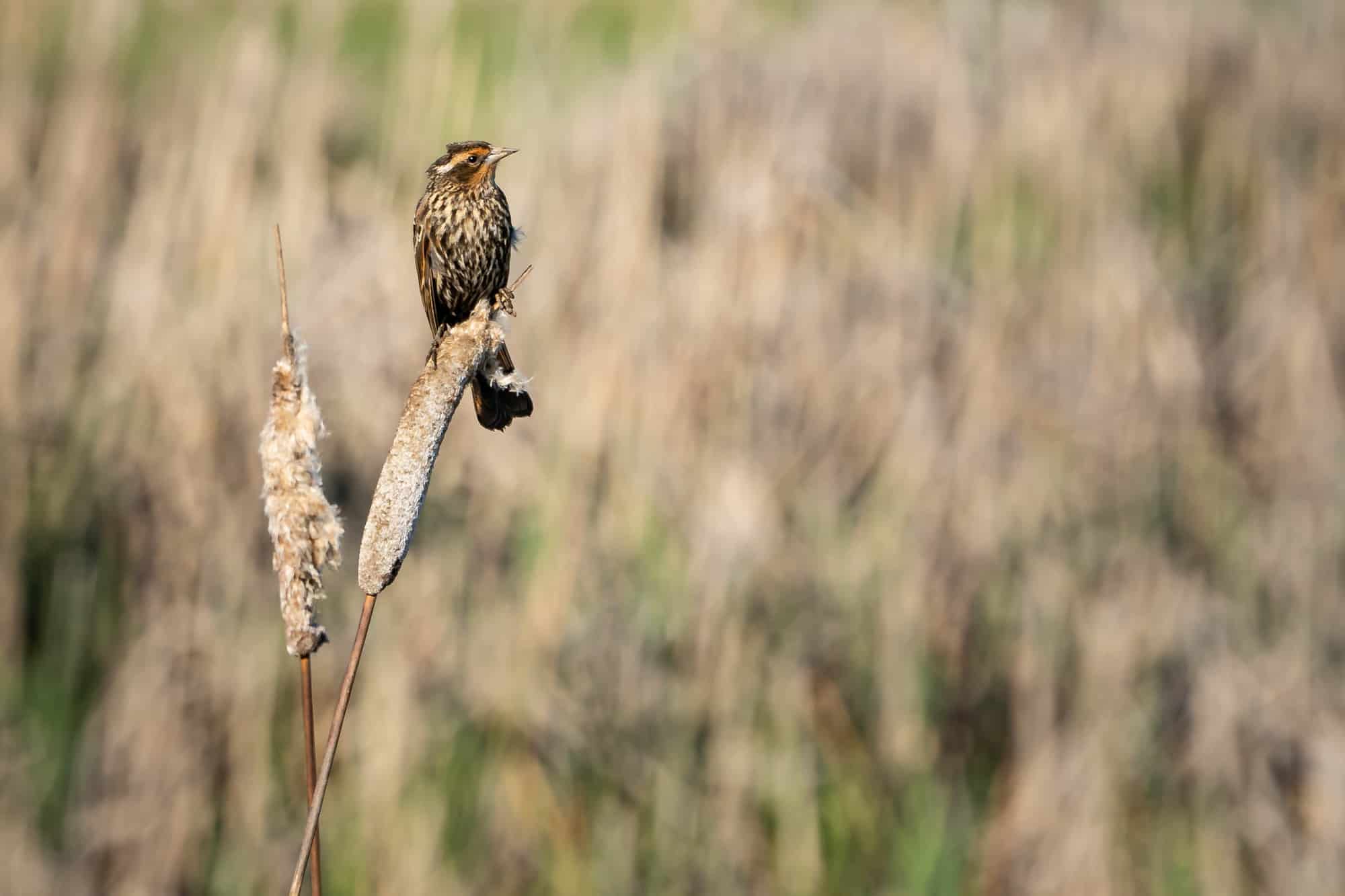
- Ammospiza caudacuta
- ORDER: Passeriformes
- FAMILY: Passerellidae
- Length: 4.7-5.1 in (12-13 cm)
- Weight: 0.6-0.8 oz (17.1-24.1 g)
- Wingspan: 6.5-7.7 in (16.5-19.5 cm)
In contrast with birds like the House Sparrow which are found throughout the entire US and much of North America, Saltmarsh Sparrows have a very tiny range. They live along the East Coast of the US and only migrate a short distance between summer and winter territories.
These little sparrows don’t even inhabit the Chesapeake Bay, choosing to stay put on the coast near and to the south of Ocean City.
Saltmarsh Sparrow males and females look similar to one another. They are gray on top with a creamy brown belly and chest. They are washed in a light yellow color and have white stripes on their back. They have orangeish-brown faces.
Saltmarsh Sparrows are excellent at camouflages, hiding among the marshy vegetation along the water’s edge. Their nests are so close to the water that their nests often get flooded at high tide.
Savannah Sparrow
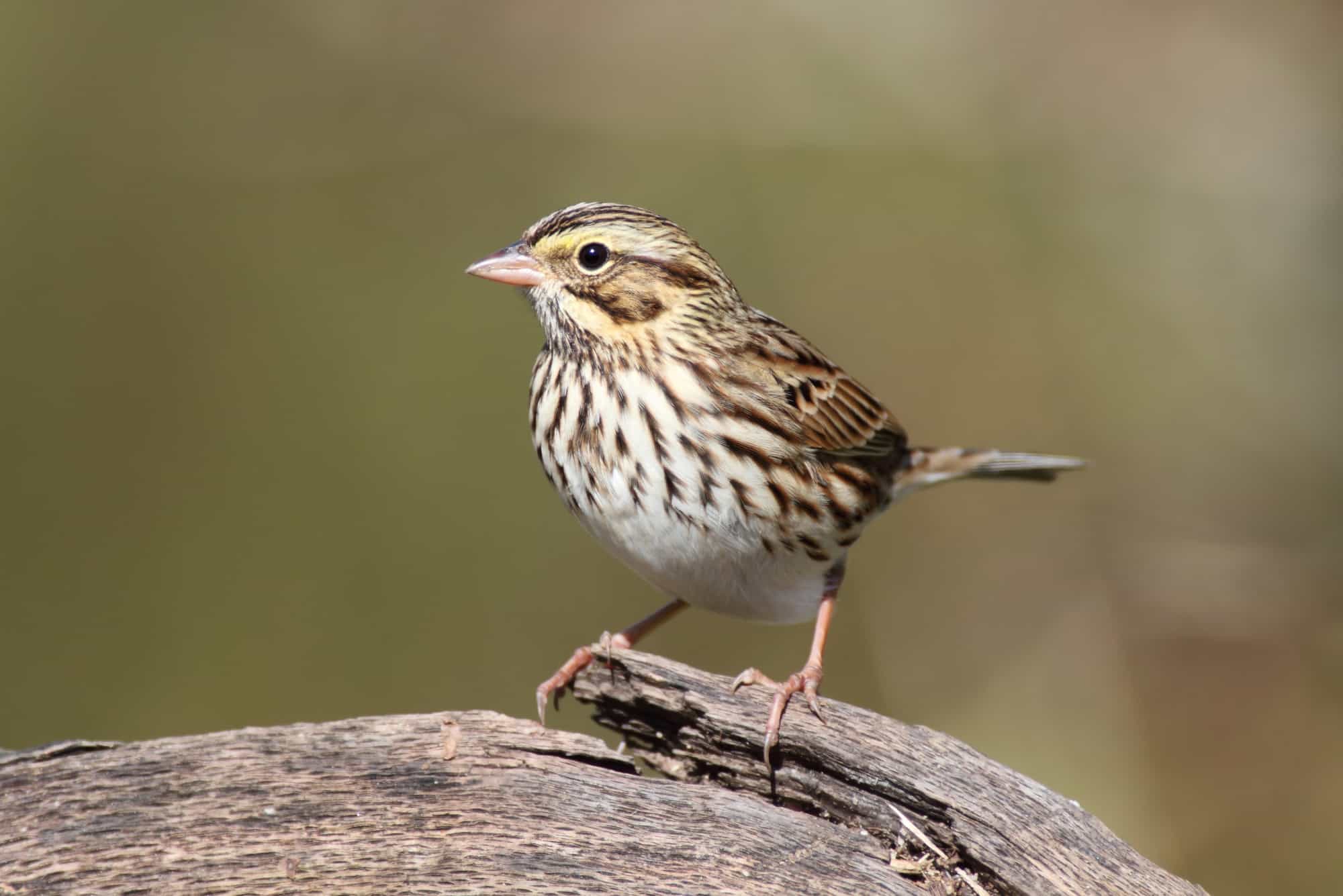
- Passerculus sandwichensis
- ORDER: Passeriformes
- FAMILY: Passerellidae
- Length: 4.3-5.9 in (11-15 cm)
- Weight: 0.5-1.0 oz (15-28 g)
- Wingspan: 7.9-8.7 in (20-22 cm)
The yellow spot between a Savannah Sparrow’s eyes will help you recognize this little brown bird. Aside from this marking, Savannah Sparrows are pale in color with dark brown streaks.
The Savannah Sparrow is pale with dark brown streaks. The yellow spot between its eyes and bill helps it stand out from other similarly colored sparrows, though.
The head of a Savannah Sparrow is small with a sharp little bill. Their vocalizations are a sharp, loud, buzzing sound that could be mistaken for an insect. They are willing to perch out in the open to vocalize, which is another differentiating factor between these and other sparrows.
In most of Maryland, they are winter-only residents, but they stay year-round in the Chesapeake Bay area. They nest in tall dead grasses that are leftover from the previous year’s summer growth.
Song Sparrow

- Melospiza melodia
- ORDER: Passeriformes
- FAMILY: Passerellidae
- Length: 4.7-6.7 in (12-17 cm)
- Weight: 0.4-1.9 oz (12-53 g)
- Wingspan: 7.1-9.4 in (18-24 cm)
Identifying Song Sparrows can be a bit tricky, as there are regional differences between them. All of them are brown with streaky white lines on their chests and thick white flanks. however, their coloring ranges from light to reddish brown, and some have far more streaking than others.
Song Sparrows are predictable nesters. They return to the same nesting grounds year after year — and sometimes even return to the same exact nest.
They live year-round in Maryland. In the summer, they eat insects and bugs, and in the winter, their diet switches to seeds.
Summer-only Sparrows in Maryland (Breeding Season Residents)
The 4 sparrows that live in Maryland exclusively in the summer are the Chipping Sparrow, the Grasshopper Sparrow, Henslow’s Sparrow, and the Seaside Sparrow.
Chipping Sparrow
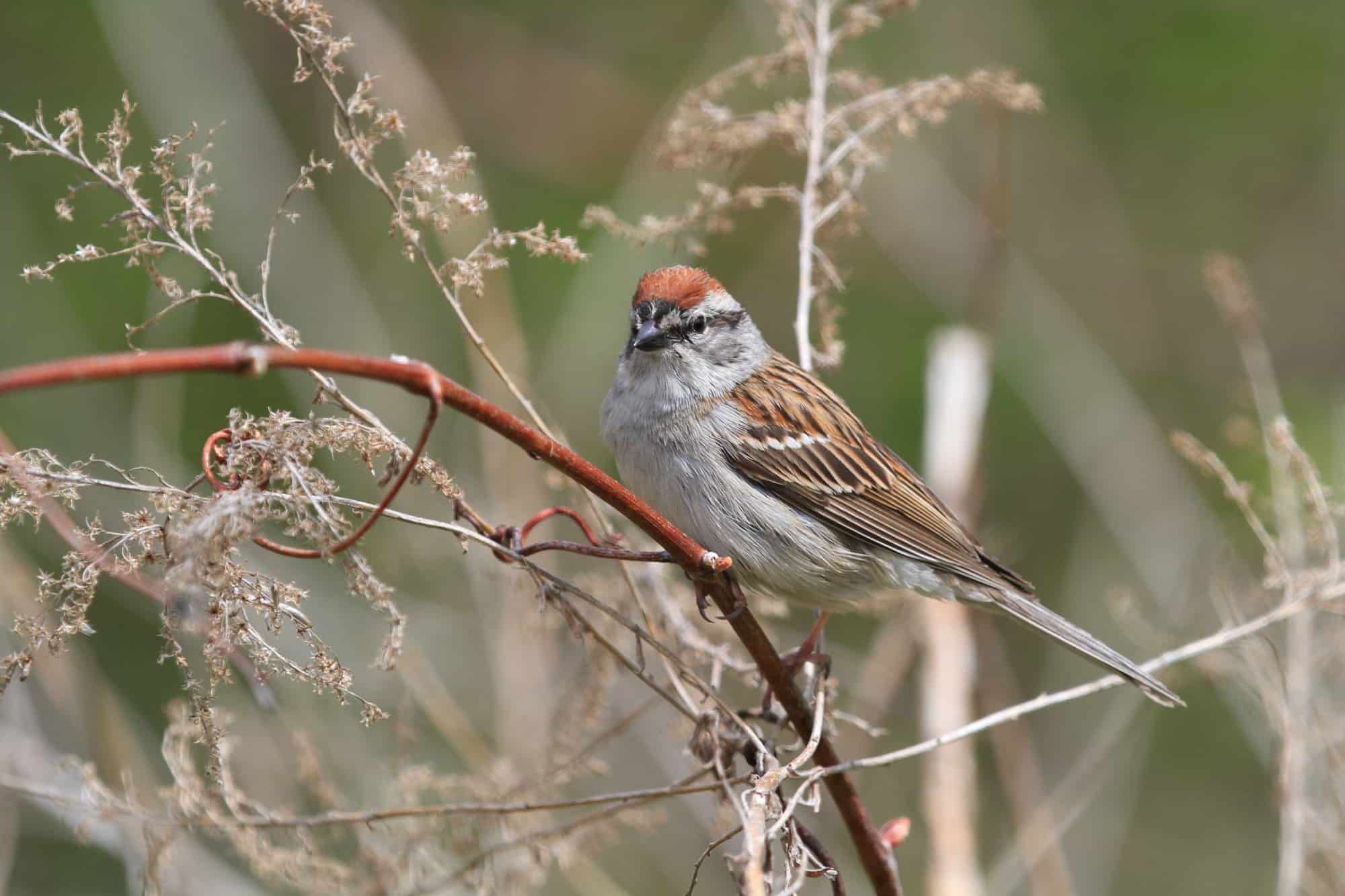
- Spizella passerina
- ORDER: Passeriformes
- FAMILY: Passerellidae
- Length: 4.7-5.9 in (12-15 cm)
- Weight: 0.4-0.6 oz (11-16 g)
- Wingspan: 8.3 in (21 cm)
The male Chipping Sparrow has a rufous-brown cap that makes him easier to recognize than some other sparrow varieties. His undersides are light gray, and his wings are streaked with dark brown. The female is lighter in color and slightly larger.
Listen for the Chipping Sparrow’s loud, trilling song in the hot Maryland summertime.
They breed throughout most of North America, including Maryland. After the breeding season, they migrate south for the winter, to places like the Caribbean, coastal Mexico, Florida, and Southern California.
They can be spotted at birdfeeders and help to control the insect population where they live. Their summer diet consists of caterpillars, beetles, some spiders, bugs, and leafhoppers.
Grasshopper Sparrow
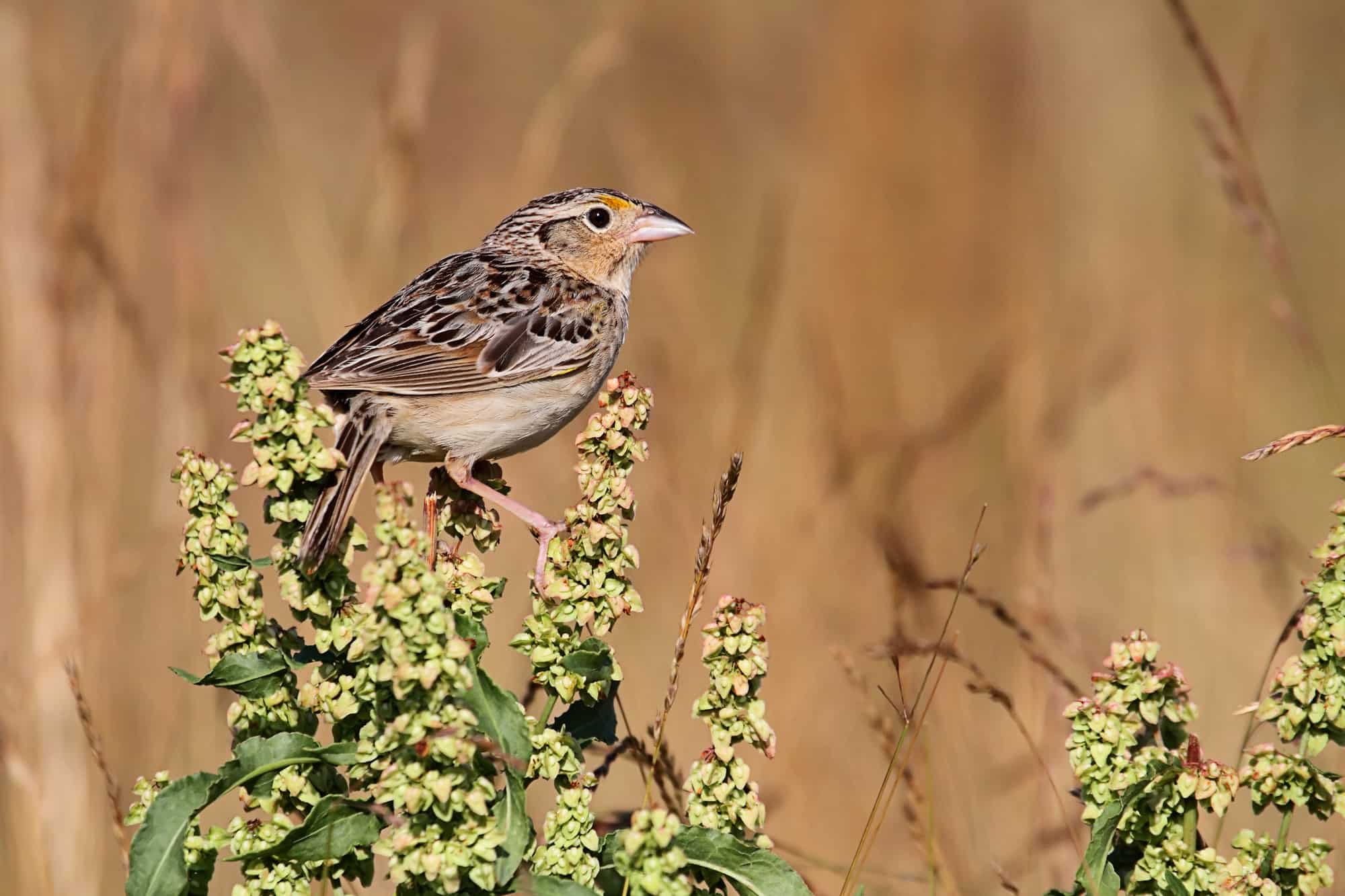
- Ammodramus savannarum
- ORDER: Passeriformes
- FAMILY: Passerellidae
- Length: 4.3-4.5 in (10.8-11.5 cm)
- Weight: 0.5-0.7 oz (14-20 g)
- Wingspan: 7.9 in (20 cm)
The Grasshopper Sparrow’s flat head, oversized bill, stubby tail, and muted coloring are key to recognizing this bird in your yard. Their coloring can range from light brown and gray to light orange.
Grasshopper Sparrows do in fact eat grasshoppers as part of their diet, but that is not where they get their name. The “grasshopper” in their name comes from the fact that their buzzzz-sounding call is reminiscent of a summer grasshopper.
Males will also produce a squeaky, melodic song while flying.
Their breeding territory extends across all of Maryland, especially in fields and prairies. They nest in tall grasses and hide very well from both predators and curious humans.
Henslow’s Sparrow
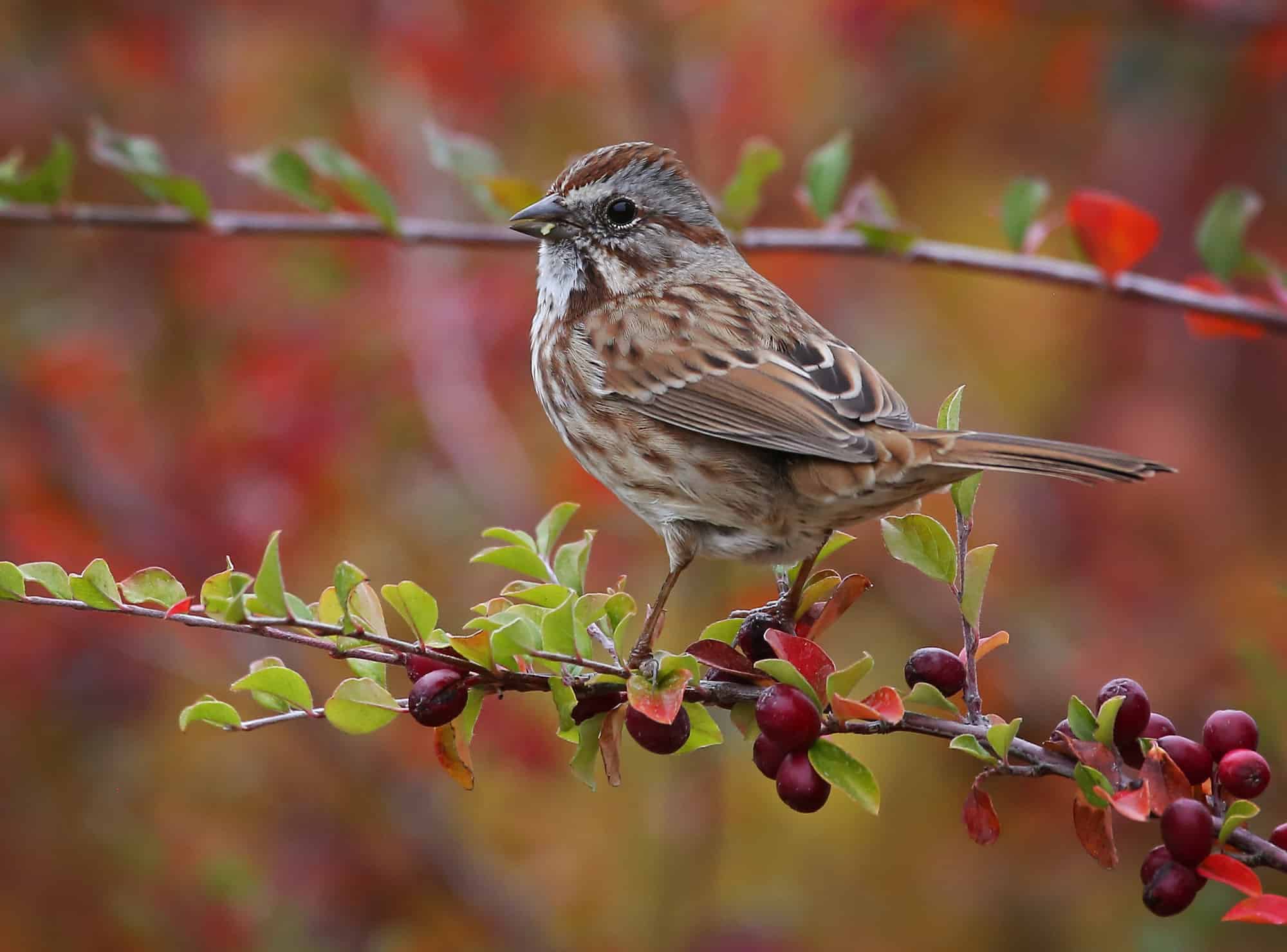
- Centronyx henslowii
- ORDER: Passeriformes
- FAMILY: Passerellidae
- Length: 4.7-5.9 in (12-15 cm)
- Weight: 0.4-0.6 oz (11-16 g)
- Wingspan: 8.3 in (21 cm)
Henslow’s Sparrows are only found in a small area of Maryland, in the middle of the Eastern Shore. They are summertime breeding residents of this area, and then they migrate to the US Southeast.
The Henslow’s Sparrow is tan and buff, with some pale green on its face. Their wing stripes are dark black, as are the stripes on their backs. They nest in tall grasses, usually on or just above the ground. They will hide their nest under an archway of grasses, helping to protect their young from predators.
Because they are the victims of habitat loss, their numbers are declining.
Henslow’s Sparrows eat a lot of insects in the summer, including grasshoppers, stink bugs, crickets, caterpillars, and beetles.
Seaside Sparrow
- Ammospiza maritima
- ORDER: Passeriformes
- FAMILY: Passerellidae
- Length: 5.1-5.9 in (13-15 cm)
- Weight: 0.7-1.0 oz (19-29 g)
- Wingspan: 7.1-7.9 in (18-20 cm)
The Seaside Sparrow is another sparrow with a lot of regional variation in appearance. All Seaside Sparrows have a long, pointed bill and a round tail. They also have strong legs and rounded wings. They don’t have a lot of markings, and their coloring is muted.
Their most distinctive marking is a yellow spot in front of each eye. They forage in the mud, so their legs need to be extra long and strong.
The Seaside Sparrow breeds along the Eastern Shore and on the west side of the Chesapeake Bay. The tall grasses on these shorelines shelter them from predators and the elements.
Winter-season Sparrows in Maryland
Maryland has more sparrows in the winter than they do any other time of year. In addition to the year-round residents, there are 7 species of sparrows that live in Maryland exclusively during the winter: the American Tree Sparrow, the Dark-eyed Junco, the Fox Sparrow, the Nelson’s Sparrow, the Swamp Sparrow, the White-crowned Sparrow, and the White-throated Sparrow.
American Tree Sparrow
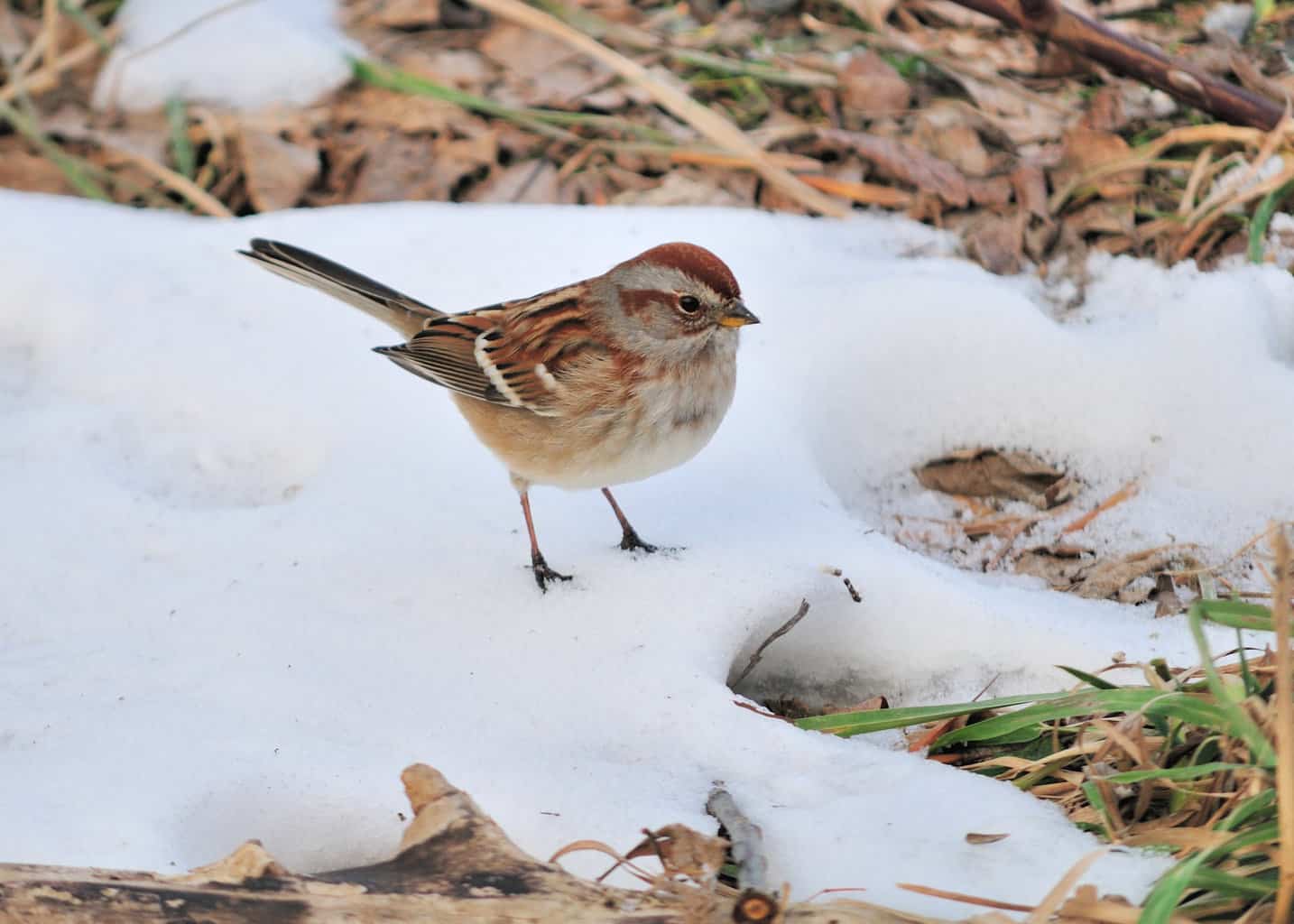
- Spizelloides arborea
- ORDER: Passeriformes
- FAMILY: Passerellidae
- Length: 5.5 in (14 cm)
- Weight: 0.5-1.0 oz (13-28 g)
- Wingspan: 9.4 in (24 cm)
The American Tree Sparrow breeds all the way into the Canadian tundra. It has a huge winter territory that stretches across most of the US.
Their bodies are gray, and their heads are deep, reddish-brown. Although the striped wings look similar to many other sparrows, watch for the red patch on its breast for quick identification. Unfortunately, some American Tree Sparrows lack that signature red breast patch.
They are found throughout Maryland in many different habitats but with a preference for snowy fields. They gather in small flocks during the winter and forage for seeds.
Dark-Eyed Junco
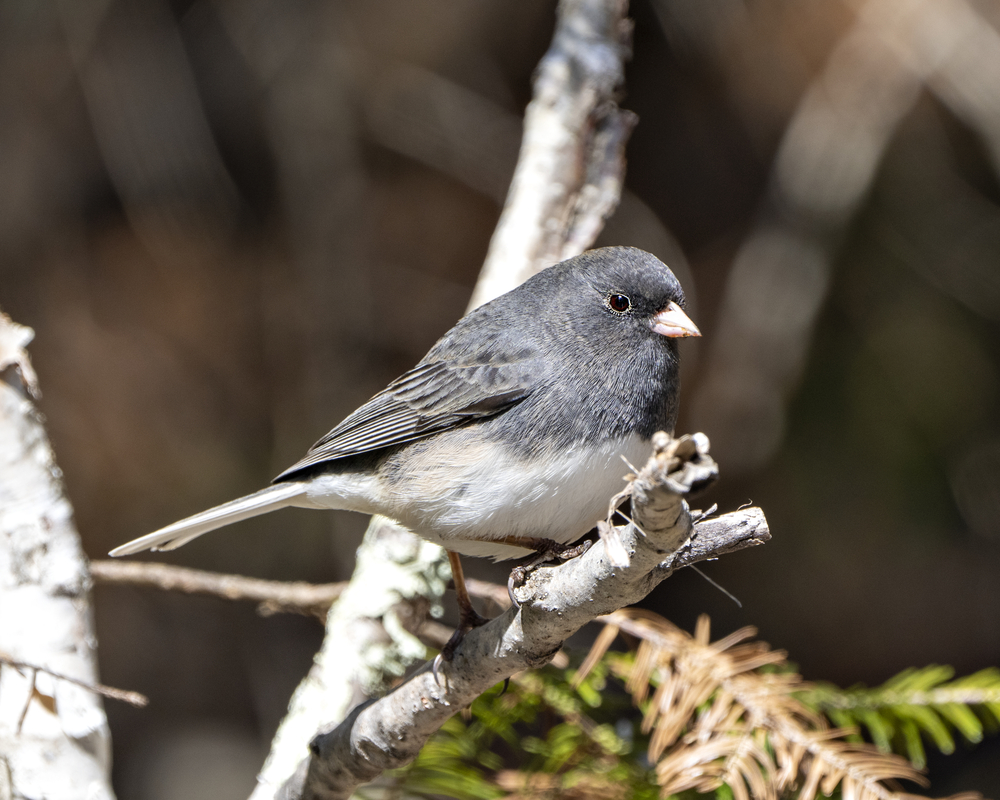
- Junco hyemalis
- ORDER: Passeriformes
- FAMILY: Passerellidae
- Length: 5.5-6.3 in (14-16 cm)
- Weight: 0.6-1.1 oz (18-30 g)
- Wingspan: 7.1-9.8 in (18-25 cm)
The Dark-Eyed Junco is distinct in its appearance when compared to other sparrows, although there are regional variations. They are usually very dark gray on top and light gray on the bottom, although their coloring can be brown, too.
In Maryland, they have a white belly and a dark gray back. Females are smaller than males and browner in color. They have a sharp pink bill.
Dark-Eyed Juncos live in mixed-coniferous forests throughout Maryland. They are also found in backyards, at bird feeders, and in parks and fields.
Fox Sparrow

- Passerella iliaca
- ORDER: Passeriformes
- FAMILY: Passerellidae
- Length: 5.9-7.5 in (15-19 cm)
- Weight: 0.9-1.6 oz (26-44 g)
- Wingspan: 10.5-11.4 in (26.7-29 cm)
Fox Sparrows are brownish-red and gray with a spotted brown chest. Regional variation affects their feather patterns, but they are usually identifiable by their reddish hue. Some will be incredibly dark red all over their bodies, and others will be streaked with dark red stripes.
Watch for these little birds in the leaf litter in and around Maryland’s forests. They kick the dirt, leaves, and sticks about as they forage for seeds and berries.
You will also spot these backyard visitors at your feeders in the winter. Look for the same habit of scratching in the dirt under your feeder for their favorite seeds.
Nelson’s Sparrow
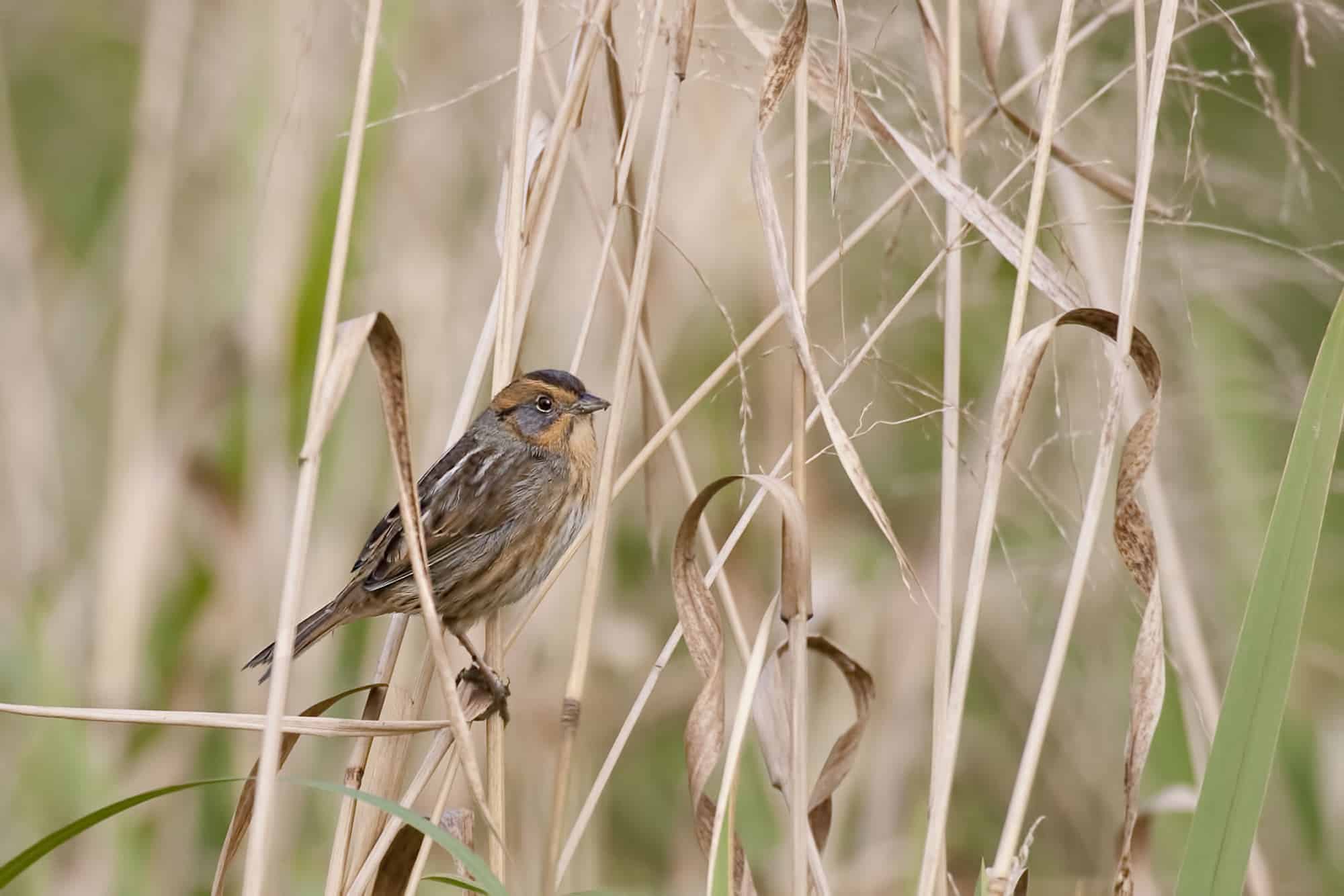
- Ammospiza nelsoni
- ORDER: Passeriformes
- FAMILY: Passerellidae
- Length: 4.3-5.1 in (11-13 cm)
- Weight: 0.6-0.7 oz (17-21 g)
- Wingspan: 6.5-7.9 in (16.5-20 cm)
Nelson’s Sparrows are saffron-yellow. Look for yellow eyebrows and markings on the sides of the face that look like whiskers. On the Atlantic, Nelson’s Sparrows are paler than their inland counterparts.
Named for the American naturalist Edward William Nelson, these birds and the very similar Saltmarsh Sparrow used to be considered one species — the Sharp-Tailed Sparrow. However, in 2009, distinctions were made between the two species.
Your likelihood of seeing a Nelson’s Sparrow in Maryland is dependent upon where you are — and when you are there.
During the spring and fall, Nelson’s Sparrows will be spotted along the Atlantic coast as they migrate. Some Nelson’s Sparrows will also spend the winter in Western Maryland.
Swamp Sparrow
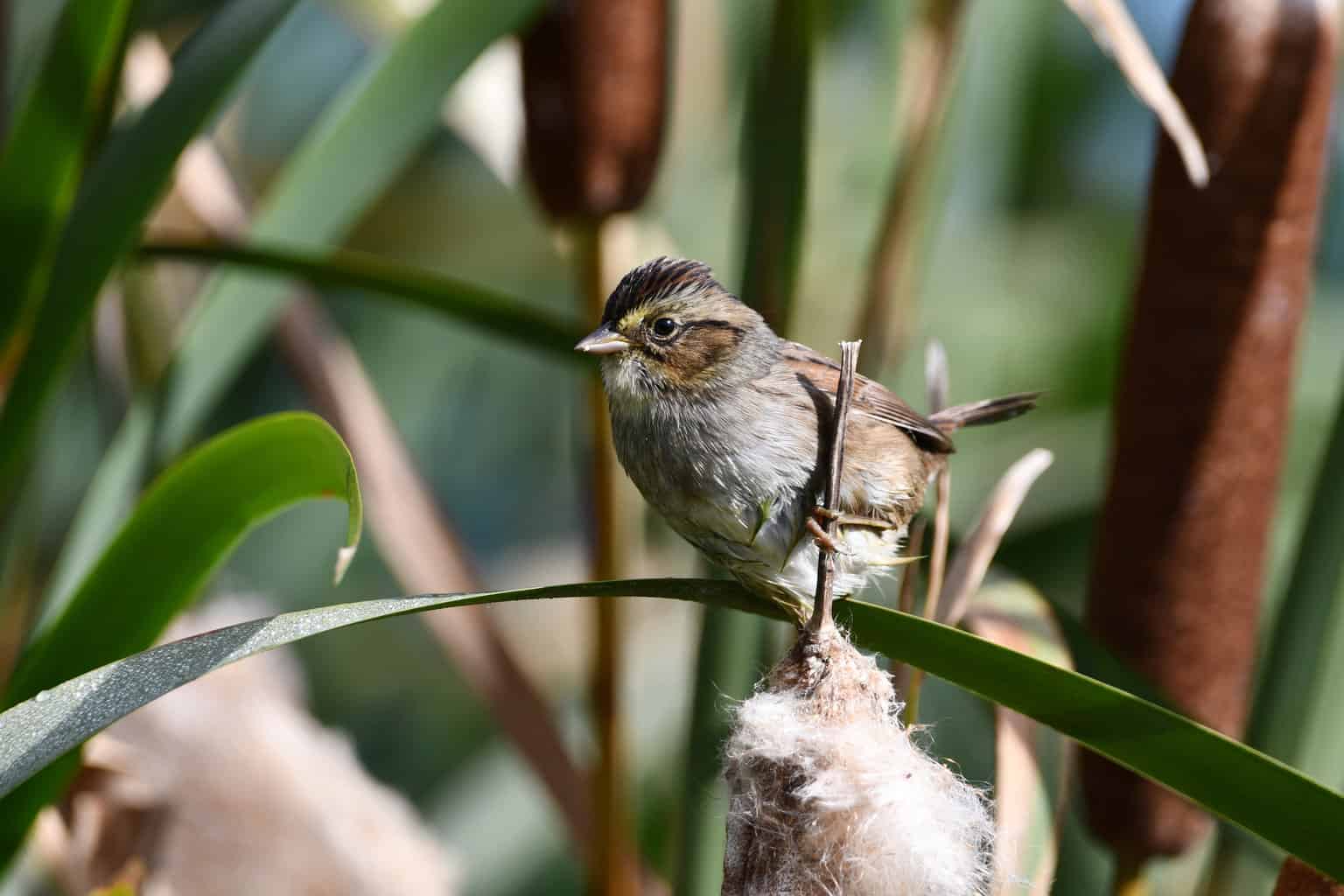
- Melospiza georgiana
- ORDER: Passeriformes
- FAMILY: Passerellidae
- Length: 4.7-5.9 in (12-15 cm)
- Weight: 0.5-0.8 oz (15-23 g)
- Wingspan: 7.1-7.5 in (18-19 cm)
The rounded shape of a Swamp Sparrow is similar to that of the Dark-Eyed Junco or Song Sparrow. They have long tails and dark brown coloring. Their wings and heads are rusty-brown.
Swamp Sparrows live in wetlands throughout Maryland. They are more commonly spotted here in the winter, although some may stay in the state year-round.
They are foragers who look for seeds, fruits, and invertebrates along the water’s edge. They stay close to the thick underbrush that gives them protection from predators. Because they forage in thick mud, they have developed long, strong legs.
White-Crowned Sparrow
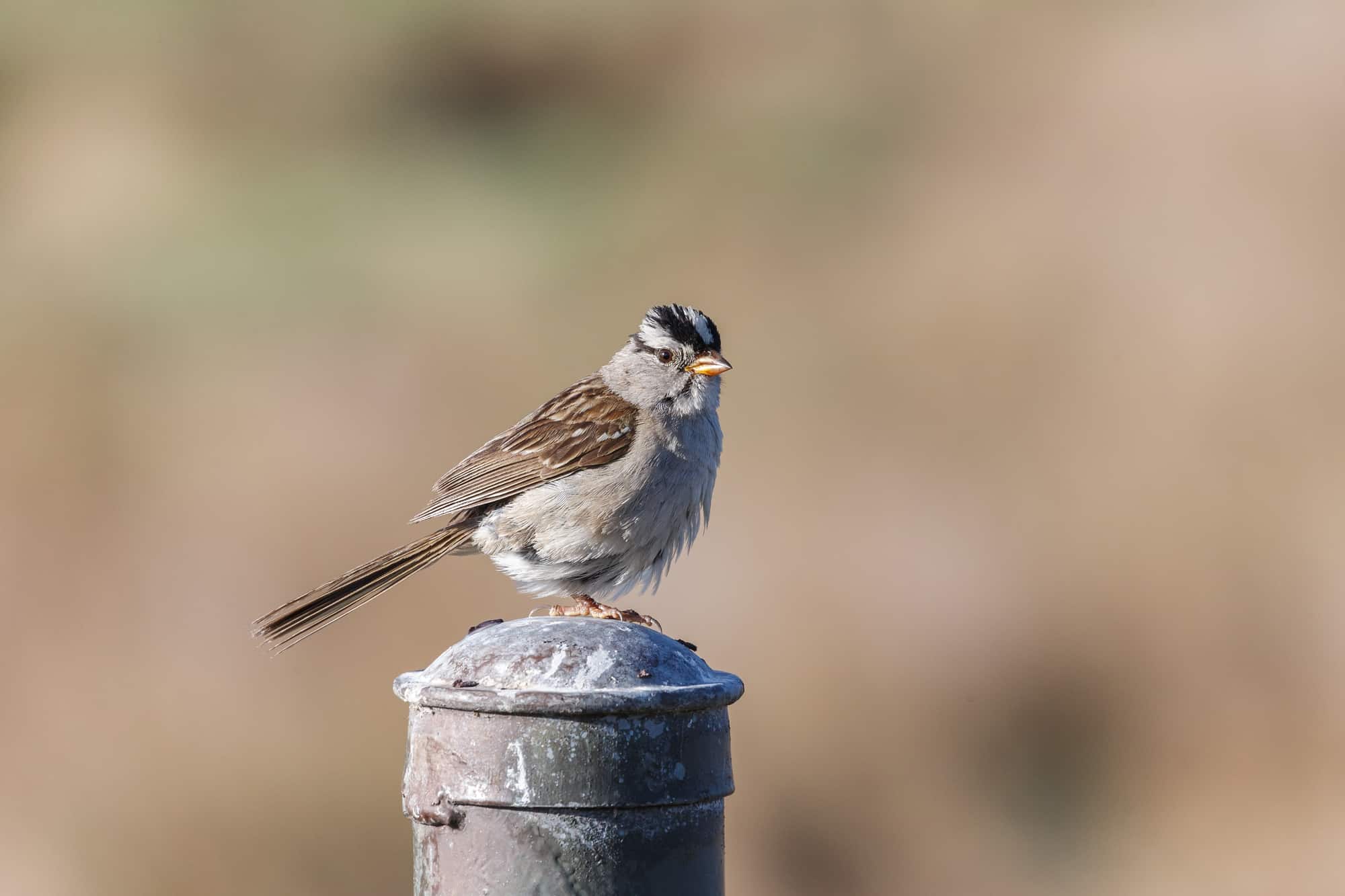
- Zonotrichia leucophrys
- ORDER: Passeriformes
- FAMILY: Passerellidae
- Length: 5.9-6.3 in (15-16 cm)
- Weight: 0.9-1.0 oz (25-28 g)
- Wingspan: 8.3-9.4 in (21-24 cm)
One of the larger sparrows in North America, the White-Crowned Sparrow has a long tail and a small pink or yellow bill. Their crown raises and lowers in communication with other birds.
The White-Crowned Sparrow has a rounded body with black and white stripes on its head.
They tend to avoid the Eastern Shore of Maryland, but otherwise, they are winter residents through most of the rest of the state. They can be found in thickets, fields, backyards, and roadsides.
White-Throated Sparrow
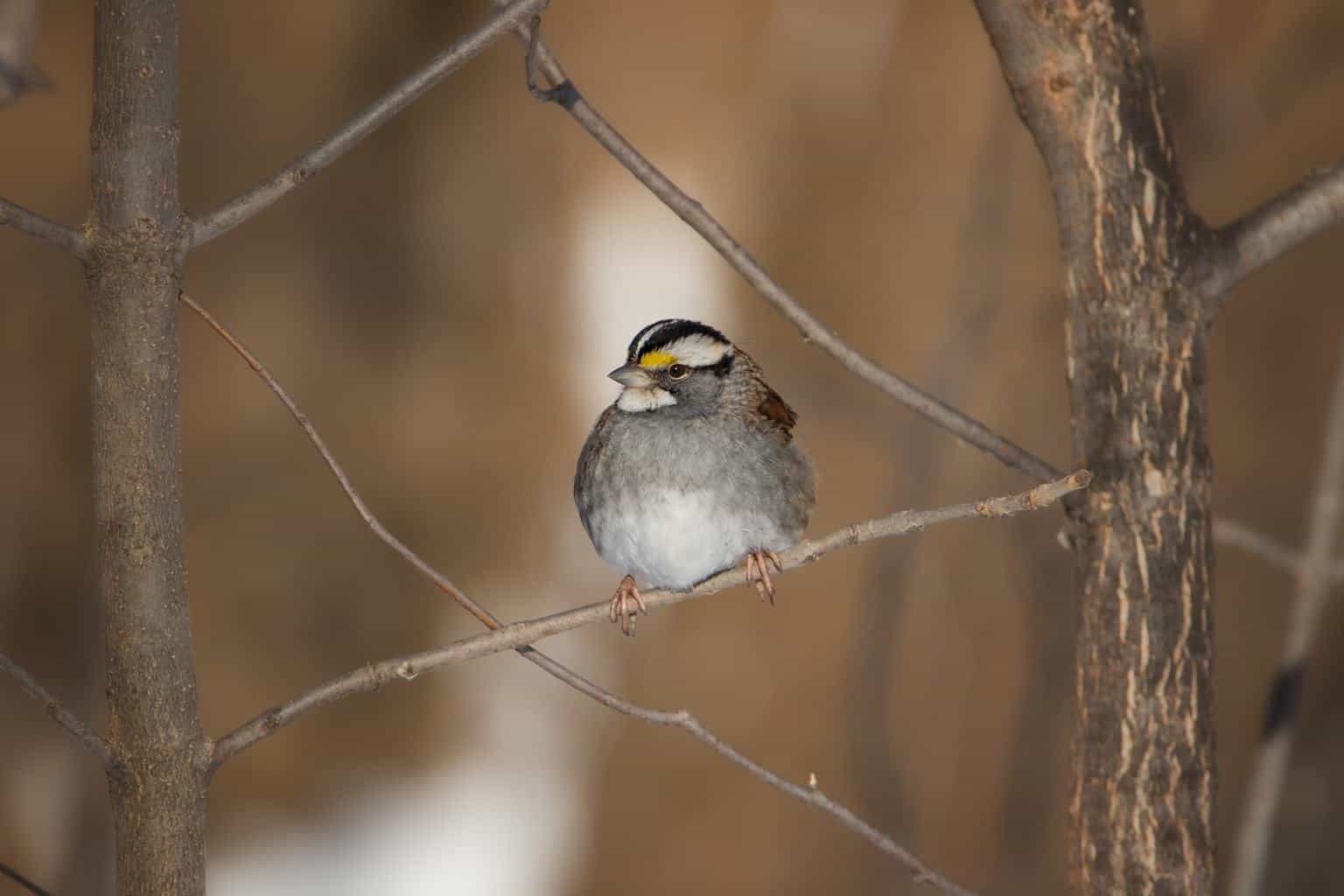
- Zonotrichia albicollis
- ORDER: Passeriformes
- FAMILY: Passerellidae
- Length: 6.3-7.1 in (16-18 cm)
- Weight: 0.8-1.1 oz (22-32 g)
- Wingspan: 7.9-9.1 in (20-23 cm)
To identify White-Throated Sparrows, look for the bright white throat and dark brown body. Their crown is white (as their name implies), and they have a black eyestripe, too. They have yellow lores. Lores are the spaces between a bird’s eye and bill.
White-Throated Sparrows are known to mate with Dark-Eyed Juncos, which creates a dull-colored hybrid.
They live in Maryland and throughout much of the American Midwest and Southeast for the winter. Their chosen winter territory is usually partly wooded, in both coniferous and deciduous forests.
Migratory Sparrows in Maryland
In addition to the 17 sparrows we’ve already listed, there are 2 species that only visit Maryland as they migrate through the area: the Lincoln’s Sparrow and the Vesper Sparrow.
Lincoln’s Sparrow
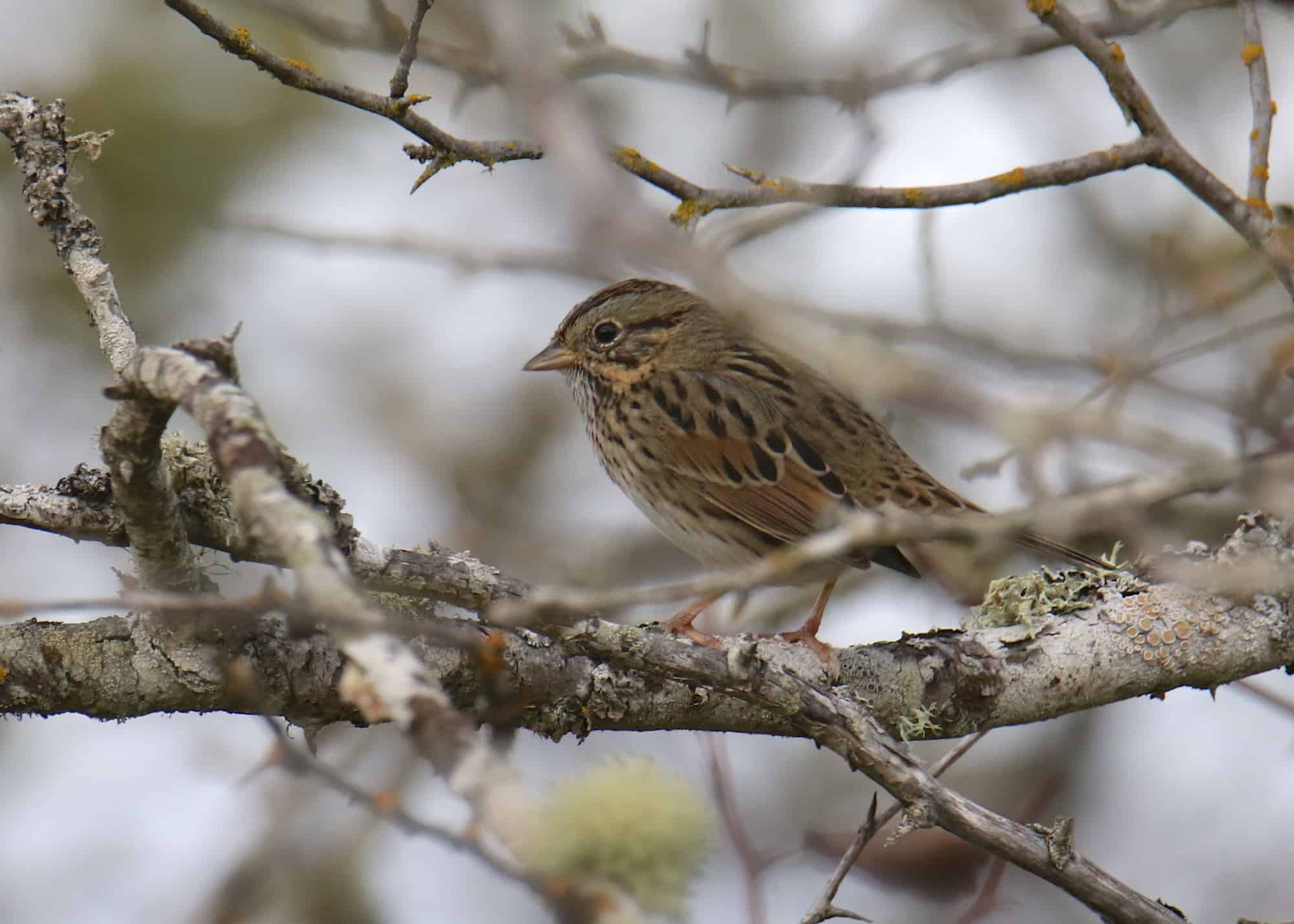
- Melospiza lincolnii
- ORDER: Passeriformes
- FAMILY: Passerellidae
- Length: 5.1-5.9 in (13-15 cm)
- Weight: 0.6-0.7 oz (17-19 g)
- Wingspan: 7.5-8.7 in (19-22 cm)
The Lincoln’s Sparrow is gray with some dark brown streaking and a white belly. Their tails and wings are tipped in rusty brown. They have a pale stripe from the bill down their chins, toward the back of their heads. In the middle of their crown runs a gray stripe.
Lincoln’s Sparrows migrate through Maryland twice a year. They are very good at going undetected, so it may take some patience to see them. You will probably have more luck finding a Lincoln’s Sparrow if you are visiting their summer or winter habitats.
They have a musical song and stay hidden among the willows, sedges, and alder trees that grow in open meadowlands.
Vesper Sparrow
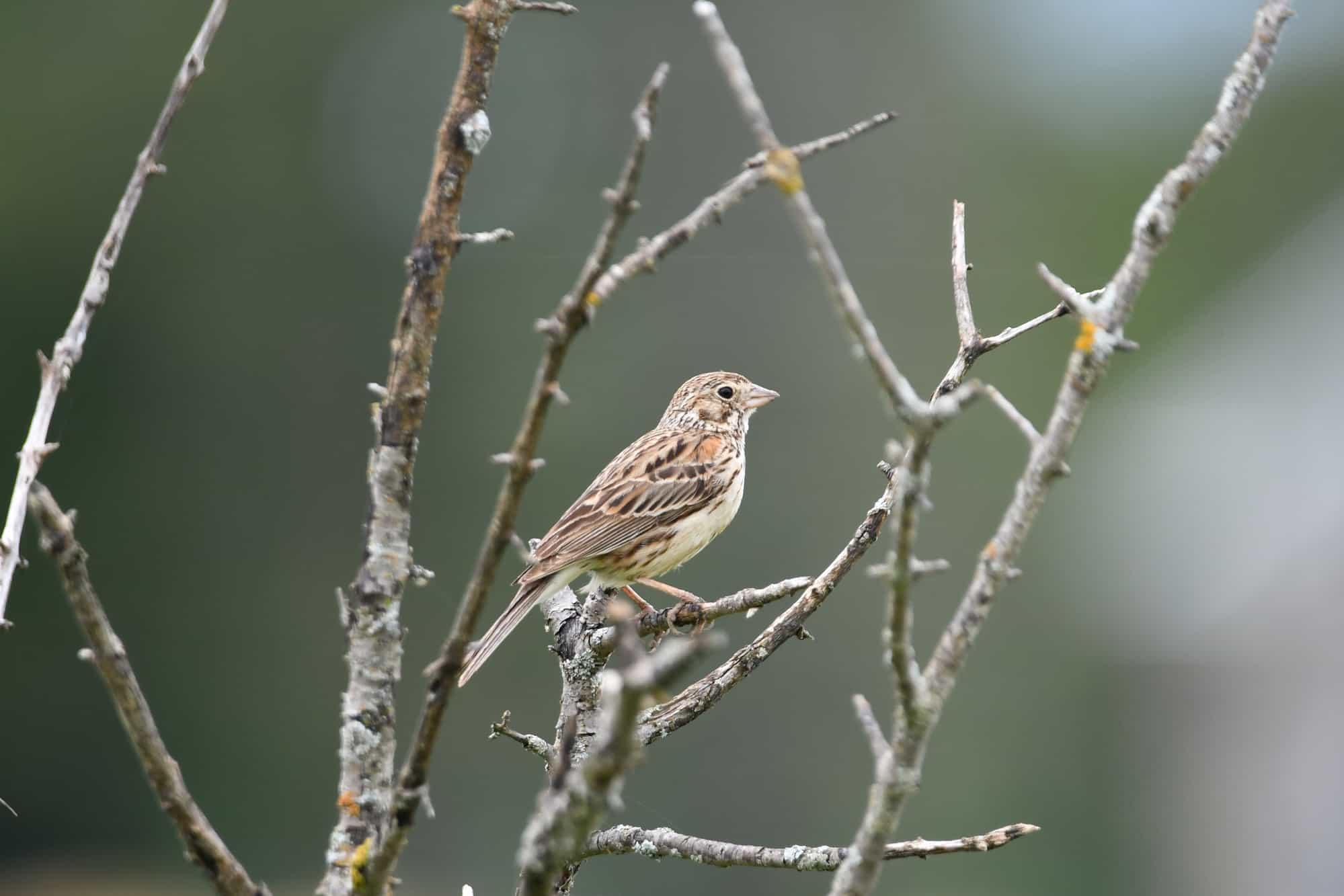
- Pooecetes gramineus
- ORDER: Passeriformes
- FAMILY: Passerellidae
- Length: 5.1-6.3 in (13-16 cm)
- Weight: 0.7-1.0 oz (20-28 g)
- Wingspan: 9.4 in (24 cm)
The Vesper Sparrow is a large sparrow with white eyerings and a brown, streaky appearance. They have a chestnut brown shoulder patch, which can be difficult to spot. They have white tail feathers, but those are really only visible while they are flying.
They get their name from the beautiful, melodic song they sing at dusk. Males perch up high and sing their song in the evening.
Although they are common North American birds, they are rare migratory visitors to Maryland.
Enjoy Finding & Identifying Sparrows in Maryland
There are so many incredible birds in Maryland, and we are confident that you will never run out of interesting birds to identify and document.
Learning to identify sparrows is quite a feat, but with time and care, it is definitely possible.

